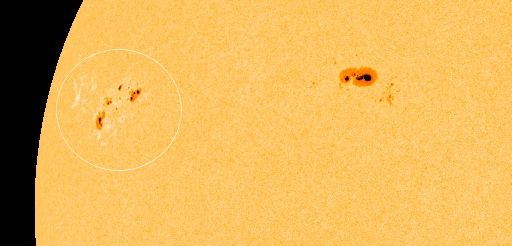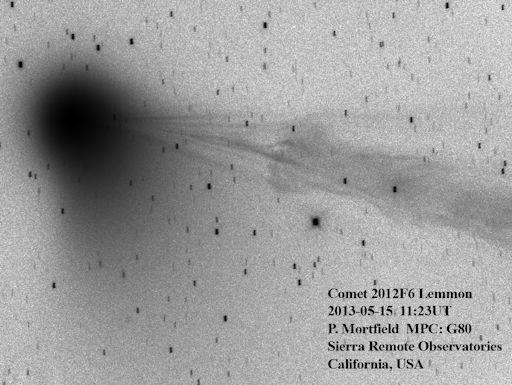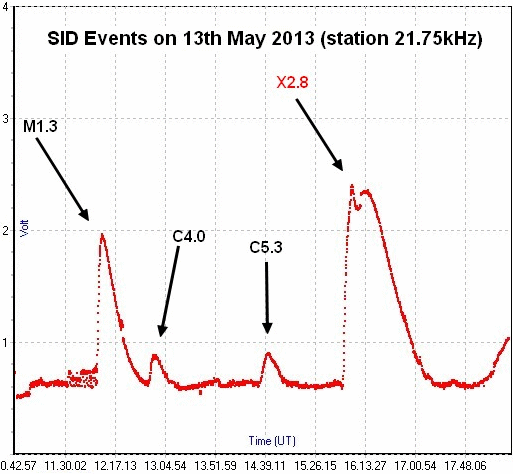They came from outer space--and you can have one! Genuine meteorites are now on sale in the Space Weather Store. | | |
POSSIBLE CME IMPACT ON MAY 17: A coronal mass ejection (CME) hurled into space by the X1-flare of May 15th might deliver a glancing blow to Earth's magnetic field on May 17th. NOAA forecasters estimate a 40% chance of polar geomagnetic storms when the cloud arrives. High-latitude sky watchers should be alert for auroras. Aurora alerts: text, voice.
X-FLARE THREAT CONTINUES: Sunspot AR1748 has already unleashed four X-class solar flares, but it might not be finished. The active region continues to grow beneath a delta-class magnetic field that harbors energy for powerful eruptions. NOAA puts the odds of another X-flare today at 60%. Solar flare alerts: text, voice.
NASA's Solar Dynamics Observatory took this picture of AR1748 during the early hours of May 16th:

The sunspot is not particularly large, but it is complex, with many dark cores scattered through its zone of influence. This is a sign of a complicated overlying magnetic field. Magnetic complexity is the source of AR1748's explosiveness: when tangled lines of magnetic force cross and reconnect--bang! A flare occurs.
All by itself, AR1748 has produced more X-flares than every other sunspot of the past year combined. In summary, AR1748 has given us an X1.7-class flare (0217 UT on May 13), an X2.8-class flare (1609 UT on May 13), an X3.2-class flare (0117 UT on May 14), and an X1-class flare (0152 on May 15). More could be in the offing. Solar flare alerts: text, voice.
Realtime Space Weather Photo Gallery
DISCONNECTION EVENT IN THE TAIL OF COMET LEMMON: Comet Lemmon (C/2012 F6), which is receding from the sun not far beyond the orbit of Earth, has just experienced a "disconnection event." A cloud of dusty plasma is propagating down the comet's tail, shown here in a photo taken by amateur astronomer Paul Mortfield on May 15th:

"I was pretty surprised to see this disconnection event when I processed the images," says Mortfield. "The comet is a challenge to photograph because it is so low in the sky at the start of morning twilight."
Disconnection events can be caused by CME impacts. A famous example is that of Comet Encke in 2007. Comet Lemmon, however, is not on the same side of the sun as active sunspot AR1748. It's hard to see how the recent X-flares can be responsible. Nevertheless, solar activity is high, so now is a good time to monitor comet tails. They are very sensitive to stormy space weather.
Comet Lemmon is a pre-dawn object for observers in the northern hemisphere. It is currently gliding alongside the Great Square of Pegasus in the eastern sky before sunrise. The 7th-magnitude comet is too faint to see with the naked eye, but it is visible in medium-to-large backyard telescopes. Observers with computerized GOTO 'scopes should point their optics here.
More about Comet Lemmon: 3D orbit, ephemeris, light curves.
Realtime Comet Photo Gallery
ION WAVES IN THE ATMOSPHERE: Although AR1748 is not directly facing Earth, its strong flares have nevertheless affected our atmosphere. UV and X-radiation hitting the top of the atmosphere ionizes atoms and molecules, creating ion waves over the dayside of the planet. Roberto Battaiola detected these waves on May 13th using a Sudden Ionospheric Disturbance monitor in Milan, Italy:

Sudden ionospheric disturbances--"SIDs" for short--make themselves known by the effect they have on low-frequency radio signals. When a SID passes by, the atmosphere overhead becomes an good reflector for radio waves, allowing signals to be received from distant transmitters. Battaiola monitored a faraway 21.75 kHz radio station to monitor the SIDs over his location.
More SIDS are in the offing as NOAA forecasters estimate an 80% chance of M-flares and a 50% chance of X-flares during the next 24 hours. Solar flare alerts: text, voice.
Realtime Solar Eclipse Photo Gallery
Realtime Aurora Photo Gallery
Realtime Noctilucent Cloud Photo Gallery
[previous years: 2003, 2004, 2005, 2006, 2007, 2008, 2009, 2011]

